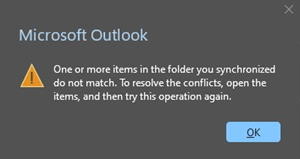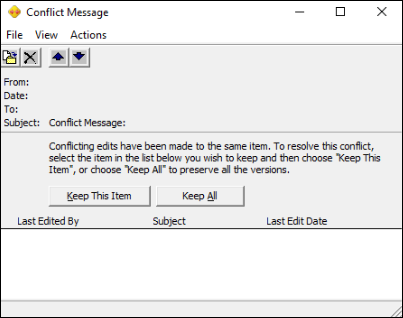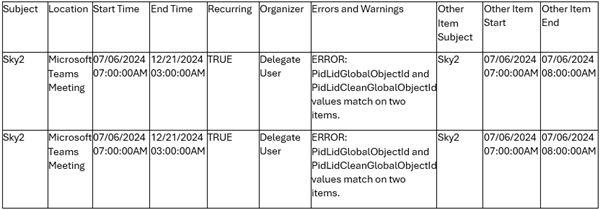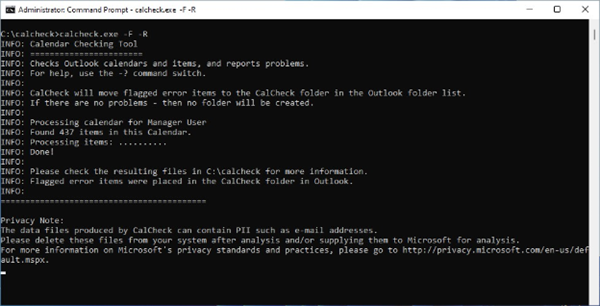Last Updated: July 18, 2024
ISSUE
When you update or cancel a meeting item in Outlook Desktop you see a conflict error.
“One or more items in the folder you synchronized do not match. To resolve the conflicts, open the items, and then try this operation again.”
Or you may get this error:
“The custom form cannot be opened. Outlook will use an Outlook form instead.”
This issue happens when there is a local conflict of the calendar item in Outlook Desktop. The server copy of the calendar item does not have a conflict.
If you are prompted with the Conflict Message dialog close it out. Using this dialog may not fully address the issue.
STATUS: FIXED
The service fix for this issue completed world wide deployment at 10:00 PM PST on 7/11/24. There is no user actions needed for this fix. Now that the fix is released you should not see new meetings cause conflicts. This issue is also published to the Service Health Dashboard as EX800425.
The service fixes are in the following builds: 15.20.7741.xx, 15.20.7762.xx, 15.20.7784.xx. You can see the service build by checking the Version column using the Outlook Connection Status dialog, see Description of the Connection Status dialog box.
Please note that the service fix will prevent new occurrences of calendar conflicts. It does not retroactively fix meetings that are already in the conflict state or that have duplicated items. Users that have conflict items only need to use Workaround 2 to clear the conflict items. Users that have duplicated meetings need to do Workaround 2 and then Workaround 3 in sequence. These steps will clear the conflicts and then remove the duplicated items.
Workaround 1:
Make meeting updates in Outlook Web Access (OWA) or use new Outlook. The conflict does not occur when updating or cancelling the meeting in OWA or new Outlook. The conflict issue is only in Outlook Desktop and only on the machine that the conflict is found. It is not on other machines or on recipients’ copies of the meetings.
Workaround 2:
To mitigate the calendar conflict issue, you can use the Clear Offline Items for your calendar. These steps clear the calendar items in the Outlook store (OST) on your local machine. After performing these steps, Outlook will sync clean copies of the meeting items from the service.
These steps do not fix duplicates. Meetings that will be fixed by these steps are those indicated by a diamond.
Example:
To clear offline Calendar items, follow these steps:
-
Close all Office Applications.
-
Open the Calendar pane in Outlook, and right-click the Calendar folder.
-
Select Properties.
-
On the General tab, select Clear Offline Items.
-
Select OK.
Notes: We received feedback that Clear Offline Items sometimes causes an error: "There was an error removing your data from Outlook data file (.ost). Out of memory or memory system resources. Close some windows or programs and try again". If you get this error use one of the following:
-
Restart your machine to remove any apps or services from locking the .OST file and do the steps again to Clear Offline Items.
-
Create a new Outlook Profile that will also sync clean copies of the calendar items. For more information, go to Create an Outlook profile. If you create a new profile you may need to recreate local signatures and client rules, if applicable.
-
Delete the .OST file for that email account. For more information, go to Introduction to Outlook Data Files (.pst and .ost).
Workaround 3:
The Calendar Team updated that the service is monitoring for duplicate calendar items and will automatically remove them. Only use this workaround if duplicate calendar items persist for more than a week.
If you got the Conflict Message dialog opening a meeting item and selected Keep All, then multiple duplicate copies of the meeting were created. If there are too many copies to easily cancel from Outlook Desktop, you can use Calcheck to remove the duplicates.
To use CalCheck to remove duplicate items on the organizers calendar created by incident EX800425, use the following steps:
-
Download CalCheck. Download Calendar Checking Tool for Outlook. For more information about Calcheck usage, please go to Information about the Calendar Checking Tool for Outlook (CalCheck).
-
On the organizers machine, create a folder c:\calcheck and extract the CalCheck zip file to this folder (right click the zip file and select Extract All..).
-
In the folder c:\calcheck, locate the calcheck.cfg and open it to edit in Notepad. You could open Notepad first and drag the calcheck.cfg into Notepad, make the changes and then save from Notepad.
-
To specifically identify and remove ONLY the duplicate items created by the incident, set DupGlobalObjectIDs=true and all other tests to false and save the calcheck.cfg file. Tip: To ensure all values except for the DupGlobalObjectIDs are set to false, use the Edit | Replace feature in Notepad to change them all from true to false. To make sure you get the calcheck.cfg correct you can refer to or use, CalCheckConfigFile.
Important: The previous step is critical because, if you don’t set the other rules to false, non-duplicate meetings might get moved to the Calchek folder in your Outlook folder list.
-
Close Outlook.
-
Open a Command Prompt window and change the directory to c:\calcheck (cd \calcheck). Type calcheck.exe and press Enter. You will be prompted for the Outlook profile with the duplicates. Pick the profile and select OK.
-
Use Windows Explorer to go to the folder c:\calcheck and open the CalCheckErr.csv. It should list the duplicated items.Example:
-
Close Outlook and Excel.
-
If you are satisfied with the list, you can now remove those duplicates. The duplicates will be moved to a new folder called Calcheck in the Outlook folder list. Go back to the Command Prompt window and type the following command and press Enter. Make sure Outlook Desktop is closed before you run the command.
C:\calcheck>calcheck.exe -F -R
-
In the profile picker window, pick the profile you need to remove the duplicate calendar items.
-
The command prompt window will show as above once it is completed. Before you close it, use Windows Explorer and go to the C:\calcheck folder and open the Calcheck.log to make sure it says it is finished and shows the current time at the bottom of the log. If completed, close the command prompt window. It will not close by itself.
Finish: 07/05/2024 11:53:30AM
Finished processing mailbox /o=ExchangeLabs/ou=Exchange Administrative Group (FYDIBOHF23SPDLT)/cn=Recipients/cn=b6121eb9ed4ea0822d864549e4f59d-manageruser
-
The calcheck.exe -F -R command created a folder named Calcheck in your Outlook folder list that has the duplicate items. If after some time you confirm the duplicate issue is resolved, you can delete that folder by right-clicking the folder and selecting Delete Folder.
-
If the duplicate items are not removed, close Outlook and run the command again and allow the command prompt window a couple minutes to complete the task.
Additional Resources
Outlook performance issues in a Cached Exchange Mode .ost or .pst file
More Resources

Ask the experts
Connect with experts, discuss the latest Outlook news and best practices, and read our blog.

Get help in the community
Ask a question and find solutions from Support Agents, MVPs, Engineers, and Outlook users.

Suggest a new feature
We love reading your suggestions and feedback! Share your thoughts. We're listening.















